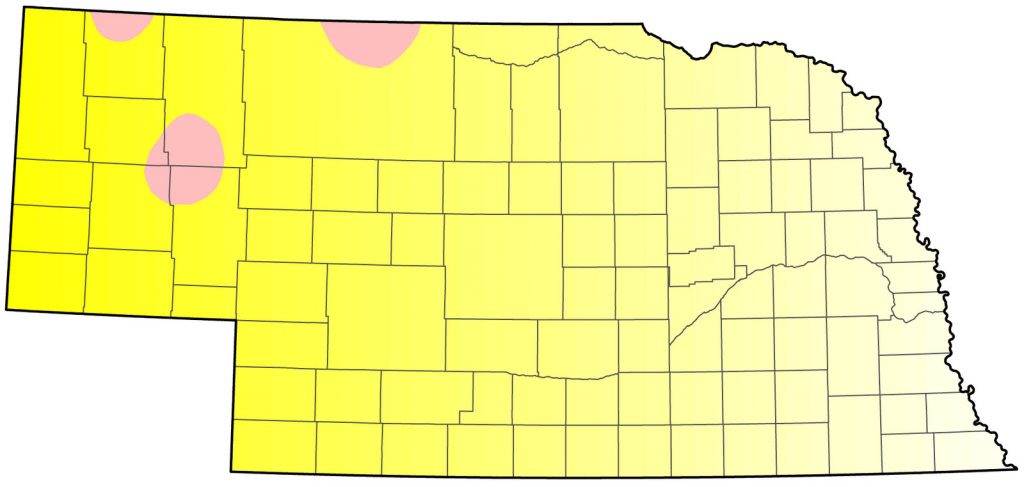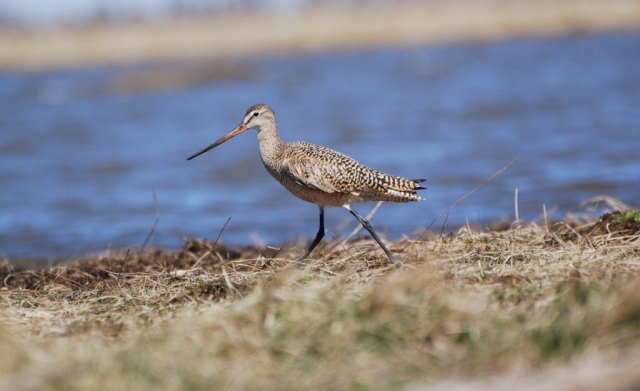Limosa fedoa FEDOA
Status: Fairly common regular spring migrant central and west, uncommon east. Rare regular breeder west and Cherry Co. Uncommon regular fall migrant west and west-central, rare casual elsewhere.

Documentation: Specimen: UNSM ZM15300, 10 May 1908 Dorey Lake, Cherry Co.
Taxonomy: Two subspecies are recognized, beringiae of Alaska and fedoa of central and south-central Canada and north-central United States (AviList 2025).
Nebraska breeders are presumed fedoa.
Spring: Apr 5, 6, 7 <<<>>> Jun 6, 6, 7
Earlier dates are 31 Mar 2025 Lancaster Co, and 2 Apr 2016 Lancaster Co. For later dates in Jun, see Summer.
Migration begins about the second week of Apr and highest counts are in the short period 22-30 Apr.
Marbled Godwit has an unusual “criss-cross” migration pattern in the mid-continent of North America (Olsen et al 2014). This species breeds in three “disparate” locations: a large population in the mid-continent prairies of North America, and small tundra-breeding populations at James Bay and in Alaska (Olsen et al 2014). Using satellite telemetry, Olson et al (2014) characterized migratory connectivity to these breeding areas (except for Alaska) of godwits from different wintering areas; those wintering at coastal Georgia migrated northwestward to breed in North and South Dakota, while those wintering at the Gulf of California, Mexico, migrated northeastward to breed in the James Bay area. The large mid-continent population, breeding mostly in south central Canada, winters at sites in Mexico after pausing at a major stopover site in Utah (Olsen et al 2014), which suggests that the fall migration pathway of most of these Canadian birds is west of Nebraska, although in spring many apparently do pass through Nebraska (see below).
Since arrival in North and South Dakota is tightly timed 15-22 Apr (Higgins et al 1979), passage into and through Nebraska of these breeders would occur in or just before this period. Marbled Godwits begin moving north on the eastern Great Plains, presumably from the Gulf Coast, at the end of Mar (eBird,org, accessed Jul 2025). However, peak spring movement in Nebraska occurs from 22-25 Apr, suggestive of larger numbers passing through the state to the northern Great Plains breeding range from coastal southern California and northwest Mexico perhaps as much as 10 days after those heading for the Dakotas. Indeed, arrival on breeding areas in Saskatchewan and Alberta is in the last week of Apr and the first half of May (Gratto-Trevor 2020). Far fewer godwits occur in Nebraska in May than in Apr, although there is a small increase noticeable in mid-May; these are likely migrants of the small (around 2000) breeding population at James Bay, where spring arrival dates are 20-30 May (eBird.org, accessed Jul 2025). Possible examples of the latter were the 25 at Jack Sinn WMA, Lancaster Co 18 May 1997 and eight at Valentine NWR, 9 May 2018.
- High counts: 900-1100 near Niobrara, Knox Co 23-25 Apr 2013 (part of a large concentration of shorebirds there), 264 at Lake McConaughy, Keith Co 22 Apr 2000, 220 at Red Willow Reservoir, Frontier Co 23 Apr 2024, and 134 in Keith Co on 24 Apr 1999.
Summer: Prior to 1990 reports of breeding in Nebraska were few. A report of nesting near present-day Columbus 9 Jun 1820 was reported by Thomas Say (James 1972), and “a godwit involved in homemaking” was at a pond in Madison Co in 1876 (Ducey 1988). Bruner et al (1904) thought it “almost certain” to breed in the state but provided no evidence. It apparently declined rapidly by 1900 during the homestead era but may be re-occupying its former range (Mollhoff 2022). Whether this reflects previously undiscovered breeding birds in Nebraska or an expansion of the South Dakota breeding range is unknown.
Recent breeding records began in 1990, when adults were defending young in Dawes Co (Grzybowski 1990). The only subsequent report from Dawes Co is of an aggressive pair 20 Jun 2006 (Mollhoff 2006). In 2008, two territorial pairs were 12-15 miles southeast of Alliance, Box Butte Co 20 Jun.
There are several reports from Sheridan Co; in 2003, a territorial pair was seen near Smith Lake WMA 15 May and later performed distraction displays there (Mollhoff 2005a). An adult was flushed from a nest with three eggs in southern Sheridan Co in 2005 (Mollhoff 2005b), and a pair with fledglings was in southern Sheridan Co 13 Jun 2006 (Ducey; Mollhoff 2006). Two were aggressively territorial in Sheridan Co 23 May 2010, and in 2022 one was near Ellsworth 12 Jun and two were at Hancock Lake 16 Jun.
There are fewer records from Garden Co; One was photographed north of Crescent Lake NWR, Garden Co 2 Jul 2016, and in 2022 two were near Lakeside but in Garden Co 10 Jun and two were at Wood Lake 16 Jun.
In Cherry Co, two pairs, one in agitated territorial flight, were near Wood Lake, Cherry Co 17 Jun 2006 (Huser; Mollhoff 2006), and a pair was in a wet meadow hayfield in northern Cherry Co 22 Jun 2008. Possible breeding birds were singles northwest of Valentine NWR, Cherry Co 18 Jun 2016, near Ashby, Cherry Co 15 Jun 2022, four at Valentine NWR 30 Jun 2022, and singles in 2023 along Wood Lake Road, Cherry Co 17 Jun and at Valentine NWR 23 Jun.
There are reports in the period 8-16 Jun that are likely immature non-breeders not completing northward migration or failed breeders moving southward. These are 9 Jun 2011 Knox Co, 10 Jun 2011 Knox Co, and 12 Jun 2009 Garden Co.
Fall: Jun 17, 18, 19 <<<>>> Sep 14, 14, 14
Later dates are 20 September 2008 (Jorgensen 2012), 23 Sep 2023 Harlan Co, 23 Sep 2023 Phelps Co, 2 Oct 2022 Lake McConaughy, Keith Co, 5-22 Oct 2023 Keith Co, 24 Oct 1973 (Cortelyou 1974), and 4-7 Nov 2023 Lincoln Co.
Migrants are found as early as late Jun, when flocks become evident; a flock of 13 at Kiowa WMA, Sioux Co 23 Jun 2023 likely comprised early fall migrants. Most have moved through by the end of Aug. In contrast to spring, fall migrants are rare east of the Panhandle and Keith Co; there are only 39 reports east of there, 19 of these in the eastern Rainwater Basin 5 Jun-24 Oct (Jorgensen 2012). Based on Olson et al (2014), it is plausible that fall migration through Nebraska from breeding areas in the Dakotas is non-stop to the Atlantic Coast, resulting in few easterly sightings in the state.
Sightings in western Nebraska in fall conceivably represent migrants from the James Bay breeding population, which migrates somewhat later (Olson et al 2014). Rather incredibly, the reports of seven individuals from four locations in Keith, Lincoln, Phelps, and Harlan Cos 23 Sep-7 Nov 2023 were all later than all but two previous late dates. The reports were of up to four at Harlan Co Reservoir, Harlan Co 23 Sep, one at Cottonwood WPA, Phelps Co 23 Sep, a juvenile at the LO Diversion Dam, 5-22 Oct, and one at Sutherland Reservoir, Lincoln Co 4-7 Nov. According to Olson et al (2014), later fall migrants through Nebraska may be from the James Bay breeding population, which winters in southern California; perhaps there was a weather-related late departure in fall 2023 from James Bay.
- High counts: 186 at Lake McConaughy 20 Jun 2004, 52 at Smith Lake, Morrill Co 5 Jul 2020, and 40 at Lake McConaughy 13 Aug 1986 (Rosche 1994).
Images
Abbreviations
NWR: National Wildlife Refuge
SRA: State Recreation Area
UNSM: University of Nebraska State Museum
WMA: Wildlife Management Area (State)
Literature Cited
AviList Core Team, 2025. AviList: The Global Avian Checklist, v2025. https://doi.org/10.2173/avilist.v2025.
Bruner, L., R.H. Wolcott, and M.H. Swenk. 1904. A preliminary review of the birds of Nebraska, with synopses. Klopp and Bartlett, Omaha, Nebraska, USA.
Cortelyou, R.G. 1974. 1973 (Sixteenth) Fall Occurrence Report. NBR 42: 22-41.
Ducey, J.E. 1988. Nebraska birds, breeding status and distribution. Simmons-Boardman Books, Omaha, Nebraska, USA.
Gratto-Trevor, C.L. 2020. Marbled Godwit (Limosa fedoa), version 1.0. In Birds of the World (A. F. Poole and F. B. Gill, Editors). Cornell Lab of Ornithology, Ithaca, NY, USA. https://doi.org/10.2173/bow.margod.01
Grzybowski, J.A. 1990. Southern Great Plains Region. American Birds 44: 1152-1154.
Higgins, K.F., L.M. Kirsch, M.R. Ryan, and R.B. Renken. 1979. Some ecological aspects of Marbled Godwits and Willets in North Dakota. Prairie Naturalist 11: 114-118.
James, E. 1972. Account of an expedition from Pittsburgh to the Rocky Mountains under the command of Major Stephen H. Long, from the notes of Major Long, Mr. T. Say, and other gentlemen of the exploring party. Imprint Society, Barre, Massachusetts, USA.
Jorgensen, J.G. 2012. Birds of the Rainwater Basin, Nebraska. Nebraska Game and Parks Commission, Lincoln, Nebraska, USA.
Mollhoff, W.J. 2005a. The 2003-2004 Nebraska nest report. NBR 73: 15-19.
Mollhoff, W.J. 2005b. The 2005 Nebraska nest report. NBR 73: 119-123.
Mollhoff, W.J. 2006. The 2006 Nebraska nest report. NBR 74: 142-147.
Mollhoff, W.J. 2022. Nest records of Nebraska birds. Nebraska Ornithologists’ Union Occasional Paper Number 9.
Olson, B.E., K.A. Sullivan, and A.H. Farmer. 2014. Marbled Godwit migration characterized with satellite telemetry. Condor 116: 185-194.
Rosche, R.C. 1994. Birds of the Lake McConaughy area and the North Platte River valley, Nebraska. Published by the author, Chadron, Nebraska, USA.
Recommended Citation
Silcock, W.R., and J.G. Jorgensen. 2025. Marbled Godwit (Limosa fedoa). In Birds of Nebraska — Online. www.BirdsofNebraska.org
Birds of Nebraska – Online
Updated 30 Jul 2025

